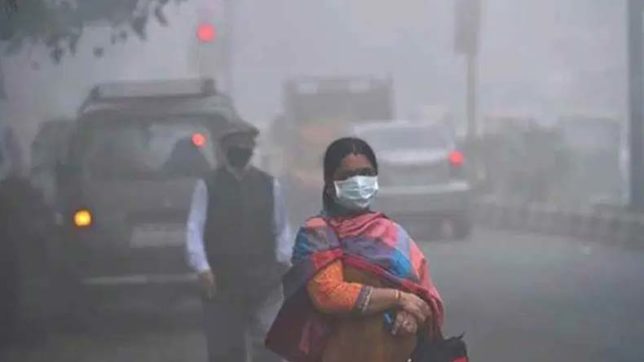The Air Quality Index (AQI) has taken a hit in Delhi with a sudden surge in the concentration of particulate, that is, PM 2.5 and PM 10 levels in the air. The pollution levels started picking up on Friday and shot up further on Saturday. As of Friday, the PM 2.5 concentration was recorded at 185 in Lodhi Road area of New Delhi which fell in the ‘satisfactory’ level while PM 10 was recorded at 201 and fell in the ‘poor’ category.
On Saturday, the air quality reached the ‘poor’ category, breaching the 200 level beyond which air quality is categorised as poor, in many areas across Delhi- 280 in Anand Vihar, 271 in Bawana, 271 in Sirifort, 213 in Lodhi Road and 214 in Punjabi Bagh. Overall, Delhi’s air quality index stood at 222. This gives hints of an imminent public health crisis as a consequence of the stubble burning season which has taken off unchecked in Haryana and Punjab.
According to environment experts, change in wind direction is one of the biggest causes behind the sudden surge in pollution levels. Previously, the wind was blowing from the east but now it has started moving from the west. While the wind speed is low, it is carrying high moisture, which has led to a rise in Delhi’s pollution levels and deterioration in air quality. Kuldeep Srivastava, head, regional weather forecasting centre had elaborated upon this issue last month and said, “At this time of the year, easterly and south-easterly winds blow in Delhi. But, by October 15, the wind directions change. Westerly and north-westerly winds that blow from Punjab and Haryana are not strong enough to blow away the pollution particles.”
The change in wind direction along with the reported instances of stubble burning in the states of Punjab and Haryana seems to be choking Delhi. When the wind starts blowing from the west, it brings in the smoke generated by the farm fires prevalent in the states of Haryana and Punjab that leads to deterioration in the air quality. As explained by Srivastava, the low wind speed also prevent the pollution particles from being blown away. As a result, Delhi’s air quality dips drastically.
As per latest reports, stubble burning has continued in the state of Haryana at an alarming rate with more than 120 incidents coming to light. Stubble burning has also begun in Punjab, with farmers complaining the the Punjab government has left them no option but to set alight their paddy harvest residue. A farmer was quoted as saying, “Punjab government does not give them any option by which they can clear the agricultural crop residues.” This reflects that both Punjab and Haryana state governments have failed to check stubble burning despite years of debate on the same issue.
A 2015 National Green Tribunal order had banned stubble burning in Rajasthan, Uttar Pradesh, Haryana, and Punjab. The act of burning crop is an offence under both the IPC and the Air and Pollution Control Act, 1981. FIRs have been lodged against the defaulters, however, they cannot be fined given the Punjab and Haryana High Court order ruling that the two states cannot fine farmers for stubble burning, and officials will not be able to find the defaulters that further complicates the issue of stubble burning.
It must be noted that last year a System of Air Quality Forecasting And Research (SAFAR), a Centre-run body had released a report according to which stubble burning in the states of Punjab and Haryana makes 32 percent contribution to Delhi’s overall pollution.
Even in 2016, an IIT-Kanpur study had highlighted this practice as a major contributor to the National Capital’s high pollution levels. In such circumstances, the approach of both the Punjab and Haryana governments has been rather casual and negligent over this issue. Despite the issue being an annual affair, the two states have not considered any significant measure to curb the menace. Had they evolved alternatives to this practice of burning crop residue which coincides with the critical time of autumn season when there is a change in wind direction that makes Delhi vulnerable to a spike in pollution levels, this issue would have been long resolved.
What is important to mention here is that 18,000 machines have been purchased with assistance of around Rs. 1,150 crore extended by the Centre to Punjab and Haryana governments. These machines are meant to convert stubble into manure that is expected to put an end to the practice of burning crop residue in the coming weeks.
The Centre has played its part, now it is upon the Amarinder Singh led government in Punjab and the Khattar government in Haryana to ensure that stubble burning is controlled in an efficacious manner to prevent an imminent public health crisis in Delhi.
